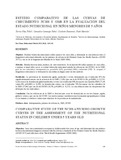Estudio comparativo de las curvas de crecimiento NCHS y OMS en la evaluación del estado nutricional en niños menores de 5 años
Fecha
2021Palabras Clave
Antropometría, Patrones de referencia, OMS, NCHSAnthropometry, Reference standards, WHO, NCHS
Metadatos
Mostrar el registro completo del ítemResumen
Objetivo: Realizar valoración nutricional a niños menores de cinco años, y determinar la concordancia entre el
diagnóstico nutricional obtenido con los patrones de referencia del National Center for Health Statistics (NCHS
1977) y con los de la Organización Mundial de la Salud (OMS 2006).
Métodos: Estudio observacional, analítico, de corte transversal. Se incluyeron 601 niños menores de cinco años,
a quienes se tomó talla y peso; se realizó valoración nutricional usando las referencias del NCHS y de la OMS,
para los tres indicadores antropométricos, peso/talla (P/T), peso/edad (P/E) y talla/edad (T/E). Se comparó el
diagnóstico nutricional y se determinó la concordancia (kappa) entre los dos modelos.
Resultados: La prevalencia de desnutrición aguda, moderada y severa determinada con el indicador P/T, fue
significativamente mayor con la referencia de la OMS (15,4%) que con la de NCHS (4,2%; p=0,0001; k: 0,254).
La frecuencia de desnutrición global moderada y severa con el indicador P/E, fue mayor con el patrón OMS (27,1%
contra 8%; p=0,0001; k: 0,290). La desnutrición crónica con el indicador T/E, fue mayor con los estándares de
la OMS (27,6%) que con los del NCHS (10,7%; p=0,0001; k: 0,273). La concordancia entre los dos patrones fue
débil para los tres indicadores.
Conclusión: Con las referencias de la OMS se detectan más casos de desnutrición en sus tres formas, aguda,
global y crónica, que con las del NCHS. Las nuevas normas constituyen una herramienta apropiada para evaluar
el crecimiento y establecer valores más objetivos de la prevalencia de malnutrición.
Información Adicional
| Otros Títulos | Comparative study of the NCHS and who growth curves in the assessment of the nutritional status in children under 5 years old |
| Correo Electrónico | nolispediatra@hotmail.com paolimariela@hotmail.com |
| Editor | SaberULA |
| ISSN | ISSN:1690-3110 |
| Resumen en otro Idioma | Objective: Carry out a nutritional assessment in children under five years of age, and determine the concordance between the nutritional diagnosis obtained with the reference standards of the National Center for Health Statistics (NCHS 1977) and with those of the World Health Organization (WHO 2006). Methods: Observational, analytical, cross-sectional study. A group of 601 children under five years of age were included, whose height and weight were measured. The nutritional assessment was made using the growth pattern of the NCHS and the WHO, for the three anthropometric indicators, weight/height (W/H), weight/age (W/A) and height/age (H/A). The nutritional diagnosis was compared and concordance (kappa) between the two models was determined. Results: The prevalence of acute, moderate and severe malnutrition determined with the W/H indicator was significantly higher according to the WHO reference (15.4%) than that of the NCHS (4.2%; p=0.0001; k: 0.254). The frequency of moderate and severe global malnutrition with the W/A indicator was higher with the WHO pattern (27.1% versus 8%; p=0.0001; k: 0.290). Chronic malnutrition with the H/A indicator was higher with the WHO standards (27.6%) than with those of the NCHS (10.7%; p=0.0001; k: 0.273). The concordance between the two reference standards was weak for the three indicators. Conclusion: With the WHO references, more cases of malnutrition in its three forms, acute, global and chronic, are detected than with those of the NCHS. The new standards are an appropriate tool for assessing growth and establishing more objective values for the prevalence of malnutrition. |
| Colación | 149-161 |
| Periodicidad | Trimestral |
| Página Web | http://www.saber.ula.ve/rvem/ |
| País | Venezuela |
| Institución | Universidad de Los Andes |
| Sección | Revista Venezolana de Endocrinología y Metabolismo: Original |






